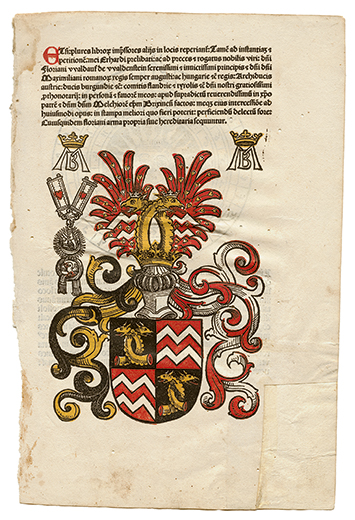Coat-of-Arms of Florian von Waldauf 1493
Hans Burgkmair
* 1473 in Augsburg † 1531 in Augsburg
Woodcut printed in black, red and yellow. Size of sheet: 31 x 21 cm.
From: Missal of the Diocese of Brixen. Augsburg, Erhard Ratdolt, 17. August 1493.
Literature: Hollstein 827. Sch. S. XII. 18.
Geisberg, German Bookillustration, vol. 8, no. 818, plate 351.
Very fine impression in unfaded colours of an early example of colour woodcuts printed from three blocks.
An early oeuvre of Hans Burgkmair, when he was working with the Augsburg printer Erhard Ratdolt. Burgkmair conceived a number of works for Ratdolt’s elaborate Missal productions. Ratdolt secured commissions for several issues and reissues of regional diocese’s Missals over several decades. These were generally expensive commissions for which Ratdolt conceived elaborate and highly decorative printed volumes. He often printed the text in two colours, black and red, as well as the accompanying woodcuts often in several colours. Ratdolt was experienced in colour printing. As early as 1476 he printed texts in black and red, 1485 he introduced the use of astronomical diagrams printed in black, red and shades of yellow-brown to illustrate Sacrobusto’s Sphaera Mundi. Ratdolt’s first figurative woodcut printed in colour is the coat-of-arms of Bishop Johann II von Werdenberg. Schramm suggests, that it was completed while Ratdolt was still in Venice, but appeared in a book he published in Augsburg 1487. Hans Burgkmair was introduced to colour printing at Ratdolt’s press in Augsburg and his conception of the art was subsequently influenced for a lifetime by the printer. Yellow printing inks from this time are rare and the colours are fugitive, and this impression seems particularly vibrant and clearly printed rather than painted (we would like to thank Elizabeth Savage for the information about the yellow ink).
Florian Waldauf, Ritter von Waldenstein (c. 1450 - 1510) was an Austrian knight in the services of Emperor Maximilian I. The son of a Tyrolian farmer, he served as a scribe to Archduke Sigismund Austria (1427-1496). When the latter resigned, he entered employment with young King Maximilian. In 1488, when Maximilian was arrested by the citizens of Bruges, Waldauf ventured to rescue him and as a result was enobled with the title “von Waldenstein”, referring to a territory in Wurtemberg. An envoy and escort to the Emperor he is important as a devouted promoter of the revival of religious thought in his time, publishing religious writings such as the Revelations of Brigitta of Sweden (Anton Koberger 1502), of which he collected and endowed relics all over Europe.
£ 4,000.-
